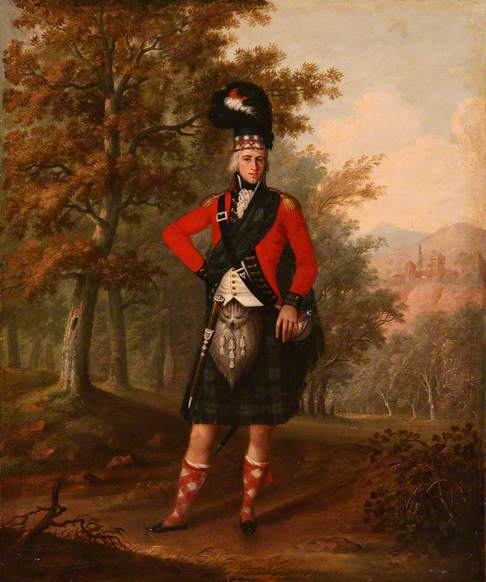Completed Dress and Textiles, Military History, Scotland: Artists and Subjects 6 comments Do you know anything further about this 'Officer of the Regiment'?

Photo credit: The Black Watch Castle & Museum
We received this comment on the painting in advance of Art Detective being established:
‘The black sword belt dates this portrait to before May 1790 when an Inspection noted the 42nd had changed their sword belts and other cross belts from black to white as ordered. The cityscape in the background appears to be Edinburgh. Assuming the subject to be a serving officer - he is not wearing either sash or gorget; an officer's principal marks of rank- this would date the portrait to autumn 1789 just after the 42nd had returned to Britain from Nova Scotia. The Regiment marched north from Portsmouth to winter at Tynemouth Barracks before continuing to Glasgow. The painting may have been executed to celebrate his return home. The two additional feathers in the black, feathered bonnet, one red and one white, are unique. Regimental tradition speaks of only red feathers for battalion companies in this period, the earliest first-hand reference being to 1776. Flank companies appear to have worn white feathers for grenadiers and green for light infantry respectively, as was becoming customary, although that is not definite.’
Completed, Outcome
This discussion has now been closed. No conclusion was reached. If any contributors have new information about this painting, we encourage them to propose a new discussion by following the Art Detective link on the Your Paintings page: http://www.bbc.co.uk/arts/yourpaintings/paintings/officer-of-the-regiment-128488
Thank you to all for participating in this discussion. To those viewing this discussion for the first time, please see below for all comments that led to this conclusion.
5 comments
I don't think that's Edinburgh at all.
Perth might be a better bet
Thanks for these thoughts.
The original comment is an interesting one, though this far from the execution of the painting, the suggestion about the location as Edinburgh is really conjecture.
One point to note - unrelated to location - is that the privilege of wearing the red hackle wasn't given to the Regiment until 1795, so the different coloured feathers may not has as much meaning as the commenter thought.
The buildings in the background probably indicate where this officer came from. Did Dollar ever have a church with a spire? Could it be Dunblane? A church at Forfar has an 18th century spire
No comment for over 3 months. I recommend this discussion be closed
